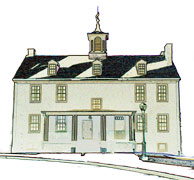


 | | | ||
 | | |||
 | | | | |
| | | |||
| | | |||
Blacks - "black", "negro" and "colored" are used throughout the records of the Merion Meeting, the onlyplace in the area for many years to accept black burials. The words of the original records havebeen reproduced in the database. Burial Ground - Quakers prefer the name "burial ground" to "cemetery." Caretakers - Take care of the property, and receive lodging in the 1804 house that adjoinsthe yard. In the past, caretakers have been involved in burials and coffin building. Children's Rows - Some rows were reserved for burial of children, some of them stillborn andnot given a first name. First Company - The first Welsh settlers who came to the area, 17 families whodivided 5,000 acres among them. Some of these families arrived as early as 1682. Free Quakers - A group of Quakers who split from the traditional Quakers by fighting in theRevolutionary War. There are about 63 Revolutionary War veterans in the burial ground.Also known as "Fighting Quakers." The Sons of the Revolution place flags on the burial sitesof a few graves known to contain Revolutionary War Vererans. Headstones - Quakers have not traditionally placed headstones on burial sites, being thoughttoo showy or worldly. Some stoneshave been placed on graves; in 1888 markers were allowed that were no more than 6 inchesabove ground. Later Quakers, believing this to be ostentatious, buried these stones.Today there are very few headstones in the yard compared to the number of burials. Someof the ones that exist were placed on the graves at a much later date than the originalburial. The oldest headstone was placed in about 1782. Indians - The term "indian" is used in the Merion Meeting records. The word in the originalrecords has been reproduced in the database. A chief was buriednext to the gate in an upright position. Members' Rows - Burial sites for members of the Merion Meeting or other Quaker meetings. Plots - There are no measured plots in the burial ground. The locations in the burial ground are not reserved for a single individual. Particularly in the oldest section of the yard, graves have been re-used several times for later burials. Stranger's Rows - Non-member burial sites. In the old section, the area furthest from the meetinghouse was reserved for "strangers and negroes." The 1801-1804 section also has several Stranger's rows. Stone Friends' Row - Although mentioned in the records, the meaning of this name is notcurrently understood. |